A New Proposition for Rooftop Gardening
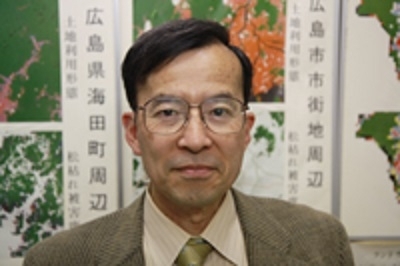
In this edition of Research NOW, we interviewed Professor Kaneyuki Nakane of the Division of Environmental Dynamics and Management, Graduate School of Biosphere Sciences.
(2009 April 9th, Interviewed by Public Relations Group, Community Collaboration and Information Policy Office)
Profile
After dropping from the Doctoral course at the Graduate School of Science of Osaka City University, Professor Nakane worked his way up from assistant to lecturer, assistant professor, and finally to professor in the Faculty of Integrated Arts and Sciences in 1992. In 2002, he became a professor at the Graduate School of Biosphere Sciences. During his time as a graduate student, the professor studied the carbon cycle in forests, however, upon taking his position at HU, the professor’s research broadened into the wider area of forest conservation including the loss of pine trees and wildfires. Currently, the professor spends his busy days as Director of the Research Center of Bio-Ecological Technology for CO2 fixation while conducting research looking for solutions to environmental issues such as using rooftop gardens that use bamboo charcoal to regenerate the water cycle in urban ecosystems, suppressing the urban heat island (UHI) phenomenon, stabilizing CO2 levels and more.
Reducing Electricity Usage Through Rooftop Gardens on ATMs
While searching for a way to promote the use of bamboo charcoal rooftop gardens, the Professor found in answer on putting rooftop gardens on the top of outdoor ATM (automated telling machine) booths. ATMs must not only maintain its computer systems, but must also keep the booth at a stable temperature, which requires the constant use of the air conditioner during operating hours. Predicting that the rooftop garden would help stabilize temperature changes in the booth, the professor began experiments on just how much the air conditioner’s electricity consumption could be minimized.
The professor and colleagues spread bamboo charcoal granules on the roof, and then planted 3 varieties of plants, including sedum. To water the plants, water was pumped from the air conditioner’s drainage pipe and an automatic sprinkler system was put into place. Rooftop temperatures were measured from June 2006 to August 2007; ATM booths with rooftop gardens did not reach above 35 degrees Celsius in the summer, however those without exceeded 80 degrees. In the winter, those without rooftop gardens plunged to minus 10 degrees; however, those with gardens did not drop below 0 degrees.
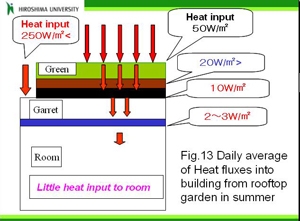
Rooftop garden system
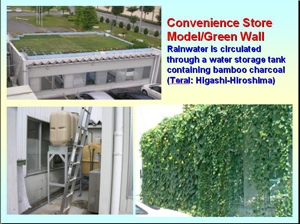
Sprinkler system (bottom left: the water storage tank circulates rainwater and automatically waters the plants)
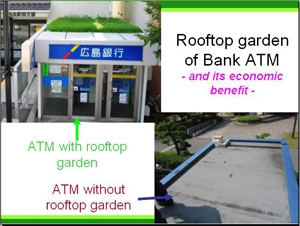
Rooftop garden ATM and non-rooftop garden ATM
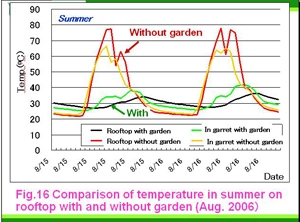
The cap for rooftop temperatures of rooftop garden ATMs in the summer is 40 degrees Celsius at the maximum (non-rooftop garden ATMs go above 70 degrees).
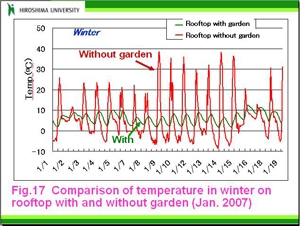
Graph for winter temperatures for rooftop garden ATMs (lowest temperatures range from 5-10 degrees Celsius).
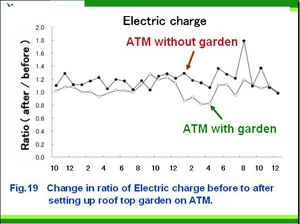
Electricity bill comparisons.
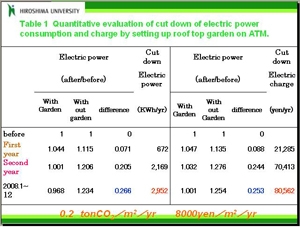
Electricity bill reduction values.
If this is all true, then why, despite the growing problem of the UHI phenomenon, aren’t rooftop gardens being employed?
Rooftop Garden Difficulties
While using relatively empty roofs for rooftop gardens has become a topic of focus in diminishing the UHI phenomenon in big cities, rooftops are quite harsh environments for plants with hot, dry summers, and harsh cold of rooftops compared to ground temperatures in the winter.
In addition to lots of water, soil (with water storage and retention capabilities) is needed to grow plants on rooftops, and soil which can be placed on rooftops is limited in both amount and weight (weight-saving), constant watering (maintenance) is required in order to have the plants thrive in a limited amount of soil.
In reality, until now, rooftop systems worked on the premise of drainage water use, and not on collecting rainwater, but even after the system was installed, constant watering was still a must. On top of the extreme care required, it also required a large sum of expenses from water charges to human labor charges.
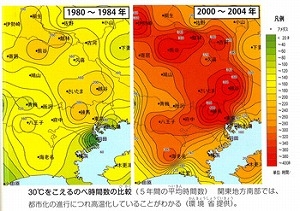
Chart from Professor Nakane’s book, “The Strange Power of Bamboo Charcoal”.
The Current State of Bamboo Forests
From bamboo works, instruments, fishing poles, and laundry poles, items made from bamboo which were once closely linked to our daily lives, now appear in the form of plastics made primarily from oil. These plastics have replaced bamboo, which is no longer being used in large quantities.
The harvesting of domestic bamboo shoots, the familiar spring mountain vegetable, has also decreased due to the recent pressure from cheaper imported bamboo shoots. “If bamboo shoots are not harvested, the shoots rapidly develop into adult bamboo within the year,” which means that woodland forests could become bamboo forests in the blink of an eye. It is this possibility which worries the professor. The underground roots of bamboo are 2-3 centimeters thin, and are limited to the shallow depth of only 20-30 centimeters in the soil. As such, their ability to firmly hold to the soil and to soak up rainwater is weak, which means that areas with large amounts of bamboo are vulnerable to landslides and floods during heavy rains.
Since bamboo and their shoots are left unused in uncultivated mountain areas around the country, the ignored forests become the root of many issues of consequence to our society such as the erosion woodland forests and farmland, invasion of forested areas, landscape and scenery changes in mountain areas, reduction in the diversity of life, and the destruction or extinction of valuable plant life residing in mixed woodlands.
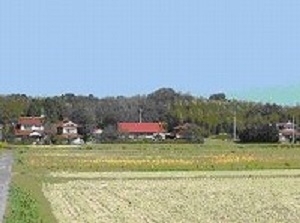
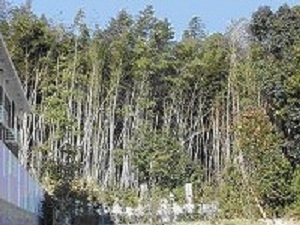
Recent scenes from uncultivated woodlands (Higashi-Hiroshima City). Bamboo forests, left unchecked, continue to expand to the surrounding areas.
However, the charcoal made from this bamboo not only has spectacular water storage and water retention, but it is also recognized for its ability to promote plant growth. The professor has big hopes for this charcoal: together with finding a use for large amounts of bamboo through charcoal production, bamboo charcoal will also play a central role in solving the environmental problems and global warming which confront us.
The Strange Power of Bamboo Charcoal
Bamboo charcoal is made by roasting bamboo in a kiln. As the inside of the kiln is lacking in oxygen, flames do not appear, even at high temperatures (the bamboo would be reduced to ashes if burned), and the bamboo is smoked as it becomes charcoal.
If observed through a microscope, you will see that the charcoal is made up of a beehive of numerous pores surrounded by thin walls. According to the professor, the pores of bamboo charcoal are smaller, and more numerous when compared to wood charcoal. Thanks to the thin walls, bamboo charcoal has many times the amount of water storage abilities than wood, which is also related to the fact that even if bamboo charcoal dries, it doesn’t easily give up the water it has absorbed.
Also, due to the fact that 1 gram of bamboo charcoal has several hundred to 1,000 square meters of surface area, it is able to provide a space for many microscopic organisms, and the variety in pore-size means that microscopic organisms of many sizes and varieties are able to live there.
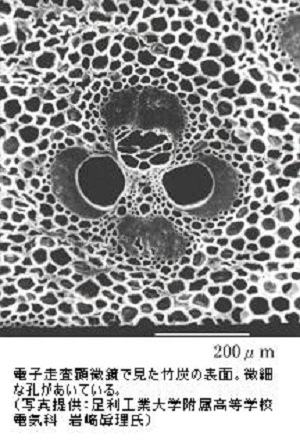
The surface of bamboo charcoal as taken by a scanning electron microscope. Many microscopic pores are visible. (Photo provided by Mr. Masato Iwasaki, Ashikodai High School)
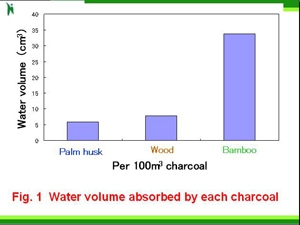
Charcoal bamboo is in a class by itself in the charcoal world – its ability to store water is tremendous.
And perhaps the most important difference is that bamboo charcoal is lighter than wood charcoal. The weight of 1 cubic cm is 0.2-0.3 grams for bamboo charcoal, versus 0.4-9.45 grams for wood charcoal (broadleaf, oak, evergreen oak). Bamboo charcoal has proven to be a fantastic resource as a material for rooftop gardens, which require lightweight materials.
Charcoal is made up of approximately 90% carbon. The remaining elements are oxygen and minerals such as nitrogen, potassium, magnesium, calcium, etc. Bamboo charcoal contains large amounts of potassium and magnesium, and a relatively small amount of calcium, making it rich with minerals to promote healthy soil.
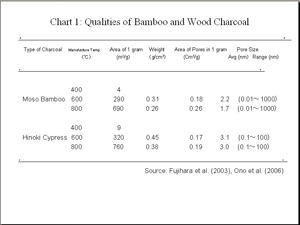
Chart 1: Comparison of the characteristics of bamboo charcoal and wood charcoal (Japanese cypress)
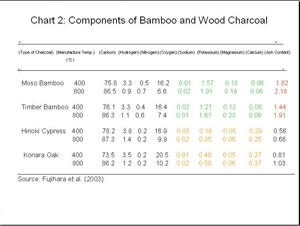
Chart 2: Comparison of the mineral percentages of bamboo charcoal and wood charcoal
Further surprising effects…
“Bamboo charcoal also functions as a water purifier,” says the professor. The microorganisms living inside of bamboo charcoal absorb the nutrients (the water impurities), and those nutrients are absorbed by the roots from the microorganisms, which promotes the growth of plants in the soil. Bamboo charcoal was placed in a water tank along with killifish, which can only survive in clean water. The fish were kept for 3 years, and despite never having changed the water even once during the 3 year period, the water was clear and a water quality analysis revealed that the water was about as clean as ordinary tap water. The reasoning is thought to be that extra food and fish droppings attached themselves to the bamboo charcoal, and were subsequently broken down by the microorganisms in the charcoal. This means that water storage, water retention, plant growth promotion, and water purifying elements are all contained in bamboo charcoal.
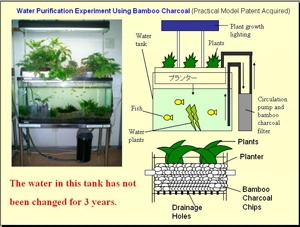
Water purification demonstration experiment with bamboo charcoal.
Turning Ideas into Reality
In the summer of 2001, the president of a certain company paid Professor Nakane a visit. He had come to Professor Nakane with a dilemma: “I’m manufacturing a large amount of bamboo charcoal in Thailand, but I’m having trouble thinking of a use for it.” While listening to his story, the professor’s attention was suddenly taken by a news report on TV: “Rooftop gardens eliminate the need for air conditioners. However, there are issues with the equipment, particularly with watering equipment.” It was then that the professor came upon an idea, “if bamboo charcoal is added to the soil of the gardens, then watering might not be such a problem—better yet, you might not even need to water it at all!” With this idea, the professor began to run an experiment to measure the effects of soil with added bamboo charcoal on rooftop gardens, using the roof of the Graduate School of Biosphere Sciences!
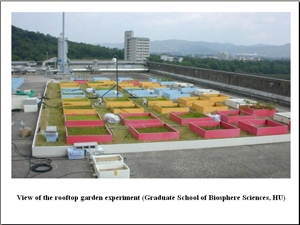
The Hilltribe People of Thailand
The hilltribe peoples of Thailand and Burma, out of poverty, began to cultivate poppy, an opiate, for money. The Thai Royal Family and the Thai government had strictly forbidden the cultivation of poppy as a means of crime prevention, and turn to growing bamboo and producing bamboo charcoal as a means to combat poverty. A foundation centered on the Thai military, whom manage the hill region on the Thai border, was established. The foundation instructed and spread to the people information on bamboo lumbering (and forestation of vacant lots) and charcoal production methods (*1).
Currently, the produced bamboo charcoal is being used in rooftop gardens in the capital city of Bangkok, and is exported to Japan with permission from the Thai Royal Family.
(*1) The Thai border area is said to have 1,000,000 hectares of bamboo forest. In comparison with Japanese bamboo, the “meat” of the bamboo pipe is thicker, and thus produces charcoal with excellent water retention. The Laos and Burma military offered to assist in planting bamboo and in charcoal production, and in 2004, an agreement was concluded between the 3 countries to mutually and jointly contribute to the enterprise. After the agreement was signed, border skirmishes ceased in large part to bamboo charcoal, contributing not only to the environment, but to world peace.
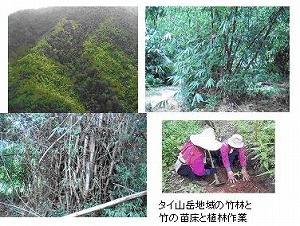
Bamboo forests in the hilly region of the Thai border. Planting bamboo and cultivating seed beds.
From the results in Thailand…
In 2003, Professor Nakane and his research team visited Thailand at the request of the aforementioned organization, and began an experiment as to how effective bamboo charcoal is as a water retention agent in the soil of rooftop gardens. The experiment was conducted on the roof of the military’s third regiment headquarters.
The trial was conducting during Thailand’s dry season (research team visited from from February to March) in which little to no rainfall occurs (during their one month stay, 8 milliliters of rainfall was recorded). To make matters worse, the temperature of the roof during the day time was 40 degrees Celsius, and while the garden was watered only once at the beginning of the experiment, the plants did not wither, and they were able to sustain lower than 30 degree Celsius temperatures in the soil.
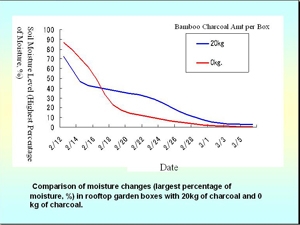
Comparison of moisture changes (largest percentage of moisture, %) in rooftop garden boxes with 20kg of charcoal and 0 kg of charcoal.
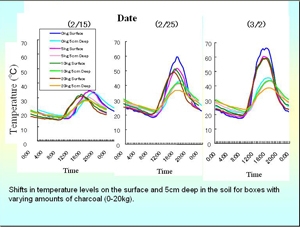
Shifts in temperature levels on the surface and 5cm deep in the soil for boxes with varying amounts of charcoal (0-20kg).
Based on the results of their research in Thailand, the professor and his research team prepared 2 soil boxes, one with bamboo charcoal and one without, and planted various plants, such as raspberry, rosemary, and blue clover, and then followed their growth and development. What they discovered was that almost all the plants in the box with bamboo charcoal grew abundantly and lived longer than those in the box without.
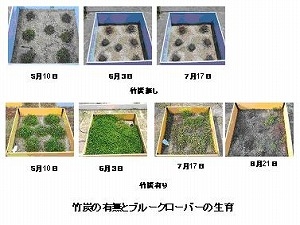
Plant cultivation experiment on the roof of the university.
The team tried to grow grass using only rainwater as a water source (no water was given to the grass). They gradually increased the thickness of the bamboo charcoal layer under the soil, and found that the thicker the layer of charcoal, the better the grass grew. Thus, they gained conclusive data that even on the rooftop under the harsh conditions of the blazing summer sun, charcoal provided the grass with the necessary water and nutrients to sustain growth.
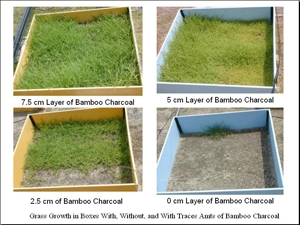
Growth condition comparison of various thicknesses of charcoal layers and of a box without any charcoal.
Toward Practical Application…
As bamboo charcoal takes in a large quantity of water, soil amounts can be reduced, and, as the bamboo charcoal itself is a lightweight material, it’s possible to make rooftop gardens even lighter. As well, bamboo charcoal made from natural bamboo won’t rot in the soil and its composition won’t change either. Thus, it’s possible to reuse the charcoal, making it a material which contributes to reducing waste, emphasizes the professor.
The traditional Styrofoam under the bamboo charcoal was also replaced with “TECO Form”, a multipurpose board born from a chance meeting (*2). The board, made from recycled plastic, is not only a cycle-model material which can be used over and over, but it’s also extremely lightweight, strong, and durable. It is also the first plastic board to be approved for Eco-Mark no. 1. Registered in Hiroshima Prefecture as a No. 1 Recyclable Product, it was certified by examination by the Industiral Technology Examination Research Institutein Hiroshima City as having 20-year durability. According to the professor, not only can we expect the board to have a lifespan exceeding that of concrete (i.e. useable until the building needs to be rebuilt), but by placing the board on rooftops, it has the added bonus of preventing rooftop surface deterioration.
In experiments using bamboo charcoal and the multi-purpose board, surprising results kept coming, and 6 different companies, all with a common awareness of the environmental problems that come with global warming, joined together, and with management and support from the Hiroshima Prefecture Federation of Small Businesses, as well as technical support from the Hiroshima Prefectural Technology Research Institute’s Western Industrial Technology Center, the Gaia Cooperative was born in 2005 as a new plant cultivation system through industry-academia-government collaboration.
(*2) Joint research with TECO Form Hiroshima began when they happened to be next to each other at a matching event held by the Hiroshima University Collaborative Research Center. This led to the development of “Bamboo TECO Gardens”, a new system for rooftop gardens using a multipurpose board using recycled plastic, perfectly suited for gardens with high durability, light weight, low cost, and excellent workability.
Future Directions and Expectations
With promotion from national and regional public organizations, rooftop gardens have been gaining media attention. According to a survey by the Ministry of Land, Infrastructure, Transport and Tourism on the amount of area used by rooftop gardens (2000-2004), it was announced that in 5 years, the area had increased by more than double.
Survey by the MLIT on the area used by rooftop gardens can be found here. (Japanese page)
Professor Nakane states that the CO2 produced by man has caused photosynthesis to become more active in forests and in the ocean, but asks if they will continue to take in CO2 in the future as they always have. Over the past 100 years, the global temperature has risen 0.6 degrees Celsius, but in the next hundred years, it is expected to rise 4 degrees – when that happens, photosynthesis will be unable to catch up.
“When you think of it that way, I don’t believe that rooftop gardens are progressing as anticipated. I do believe that cost and maintenance are where progressing is getting caught, however, by using bamboo charcoal, both of those issues are solved, thus I want to actively spread this new type of rooftop garden as much as I can,” says the professor with enthusiasm. By using once unused land to make a living for those in mountainous areas , the area is revived which is expected to be a method for both disaster prevention and as a way to bring vitality back to the woodlands.
“If rooftop gardens were put on the rooftops of convenience stores, all of the initial funding would come back to the stores through the savings in their electricity bills. If we were able to make the idea of rooftop gardens on every convenience store a reality, I can’t even imagine how much energy we’d be able to save without getting a little excited,” says the professor and it’s clear that he’s passionate about his work.
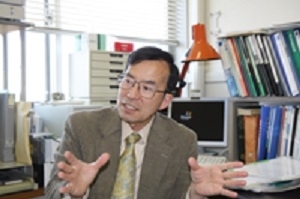
“I want to spread this technology!”
“In an introductory experiment at a golf course, it was found that water used to water the greens were reduced by 1/3rd, and that fertilizer and pesticides were reduced by half. Customers can enjoy beautiful green grass year round, and on top of the easy maintenance, you can also save on costs. Demand from dry regions such as China and Korea is expected – particularly with the large number of golf courses planned in China, I would really like to see them use this new system,” says the professor.
As the expectations rise for bamboo charcoal, which may also play a part in preventing desertification, the professor’s dreams keep building to one day having rooftop gardens on school fields and the tops of buildings. The professor is also working to teach international students who will play leading roles in solving environmental problems in their home countries upon return from Japan, and in April 2008, he published “The Strange Power of Bamboo Charcoal ~Looking for Possibilities as a Global Warming Countermeasure~”(Komine Shoten) to spread the appeal of bamboo charcoal to elementary schoolers.
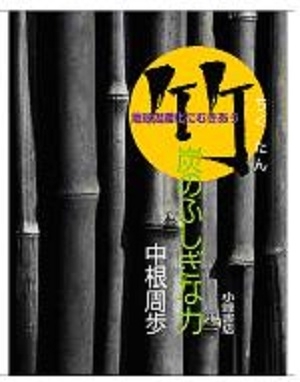
“The Strange Power of Bamboo Charcoal ~Looking for Possibilities as a Global Warming Countermeasure~”(Komine Shoten)
Afterword
While listening to the professor’s enthusiastic talk of “using this new system to turn the tops of city building into rainforests!”, this reporter was invigorated. Solar panels that produce energy, small wind turbines, and rooftop gardens that keep energy consumption down – but solar panels and rooftop gardens both take up roof space…and I found myself seriously considering which one I should choose. (O)
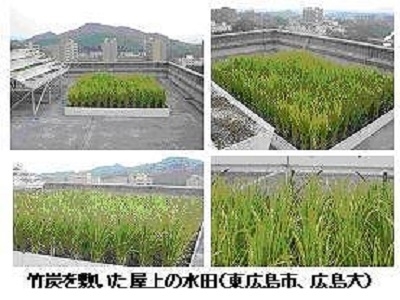
Rice fields on the rooftop of the Faculty of Integrated Arts and Sciences.
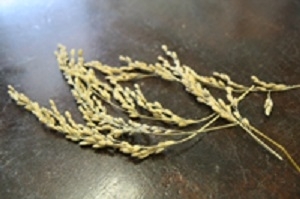
Koshihikari brand rice harvested last year from the rooftop. It will be used this year in planting the new harvest.


 Home
Home

